�
For your convenience Apress has placed some of the front
matter material after the index. Please use the Bookmarks
and Contents at a Glance links to access them.
www.it-ebooks.info
Contents at a Glance
About the Author ���������������������������������������������������������������������������������������������������������������xiii
About the Technical Reviewer �������������������������������������������������������������������������������������������� xv
Acknowledgments ������������������������������������������������������������������������������������������������������������ xvii
Introduction ����������������������������������������������������������������������������������������������������������������������� xix
■
Chapter 1: Getting Started
�������������������������������������������������������������������������������������������������1
■
Chapter 2: Hello, Glass! Your First GDK App
��������������������������������������������������������������������13
■
Chapter 3: Glass User Interface
���������������������������������������������������������������������������������������47
■
Chapter 4: Camera and Image Processing
����������������������������������������������������������������������81
■
Chapter 5: Video: Basics and Applications
��������������������������������������������������������������������113
■
Chapter 6: Voice and Audio
�������������������������������������������������������������������������������������������147
■
Chapter 7: Networking, Bluetooth, and Social
���������������������������������������������������������������175
■
Chapter 8: Location, Map, and Sensors
�������������������������������������������������������������������������215
■
Chapter 9: Graphics, Animation, and Games
�����������������������������������������������������������������249
■
Chapter 10: The Mirror API
��������������������������������������������������������������������������������������������297
Index ���������������������������������������������������������������������������������������������������������������������������������337
www.it-ebooks.info
v
�
Introduction
Google Glass is a wearable computer developed by Google. Although Glass is based on Android,
it is fundamentally different from existing mobile platforms. The best line to describe Glass is “There
when you need it. Out of the way when you don’t.” Glass is designed to complement a smartwatch,
smartphone, tablet, or computer.
In April 2013, the Google Glass Explorer Edition was made available, for the first time, to Google I/O
2013 developers. There were four Glass-related sessions at Google I/O 2013 held in May 2013:
nn
Developing for Glass:
https://developers.google.com/events/io/sessions/332490621
nn
Building Glass Services with the Mirror API:
https://developers.google.com/events/io/sessions/332733833
nn
Voiding Your Warranty: Hacking Glass:
https://developers.google.com/events/io/sessions/332704837
nn
Fireside Chat with the Glass Team:
https://developers.google.com/events/io/sessions/332695704
Since then, several important events have happened:
nn
On November 19, 2013, Google officially released the native Android-based
Glass Development Kit (GDK) Sneak Peek, so developers can now build native
apps in Android 4.0.4 (API Level 15) for Glass.
nn
On April 15, 2014, Google announced a major upgrade for Glass to
Android 4.4.2 (API Level 19).
nn
On May 15, 2014, Google made the Glass Explorer Edition available to any U.S.
resident older than 18 and with a U.S. shipping address.
It is almost mid-June 2014 now, and Google I/O 2014 is only a couple of weeks away. More
Glass-related sessions on how to design and develop Glass apps (also known as Glassware) and on
the Glass platform details have been scheduled (see https://www.google.com/events/io/schedule).
www.it-ebooks.info
xix
�
Introduction
xx
This is a great time to start learning Glass development; if you need more reasons, see the “Why
Glass?” section in Chapter 1. You should definitely check out those Google I/O 2013 and 2014
videos on Glass if you are interested in Glass development. In addition, Google Glass’s developer
site at https://developers.google.com/glass/ has great documentation on designing, developing,
and distributing for Glass. But none of this compares to having step-by-step tutorials with working
code examples on every major Glass development topic, using both GDK and the Mirror API. That is
exactly what this book is provides.
What’s in This Book
There are ten chapters in this book, covering every major Glass development topic.
Chapter 1, “Getting Started”: In this chapter, I’ll discuss several general topics about Glass and
Glassware: Why Glass? What is Glass and Glassware? What can you do with GDK Glassware and
Mirror Glassware? Why this book? Who is the book for? I’ll also list popular Glass development web
resources.
Chapter 2, “Hello, Glass! Your First GDK App”: I’ll first cover the detailed steps of how to set up
your GDK Glassware development environments, whether your favorite is Mac, Windows, or Linux.
Then I’ll discuss how to set up Glass to get it ready for development and how to run sample GDK
apps on it. Finally, I’ll introduce the generic template Glassware, which you’ll use to create new GDK
apps, and show you a step-by-step tutorial of building HelloGlass, your first GDK app, with nice
features such as menu actions, text-to-speech, and speech-recognition versions of HelloGlass.
Chapter 3, “Glass User Interface”: In this chapter, you’ll enter the exciting world of Glass and learn
what kinds of UI elements can be built with GDK for a Glass app. The main Glass UI elements—the
timeline, Glass-styled cards, live cards, immersions, menu items, and gestures—will be discussed in
detail with fully tested sample code that shows you how to render standard UI content, content from
an XML layout, and content created using Android’s Canvas 2D and OpenGL ES 1.0 and 2.0. By end
of this chapter, you’ll have a basic understanding of what kinds of apps you can build with GDK and
when to use which or a combination of them.
Chapter 4, “Camera and Image Processing”: In this chapter, you’ll start with how to use the Glass
camera to take pictures, both in the easy way and in the custom way, which allows you to preview
and zoom before taking a picture. Then I’ll briefly cover how to browse the photos in any directory
of your Glass. After that, I’ll discuss step-by-step many common practical image-processing tasks,
including barcode and QR code recognition, OCR, image web search, and OpenCV. I’ll cover how to
integrate the best open source libraries out there, if needed, to your own app and how to call their
APIs from within your app. By the end of this chapter, you’ll be well prepared for exploring your own
great app ideas using all kinds of image-processing techniques.
Chapter 5, “Video: Basics and Applications”: In this chapter, you’ll start with the basic video
capture and custom video capture with preview and then look at how video can play on Glass.
Then I’ll discuss how to use OpenCV to add image effects on frames extracted from video. A more
powerful video-processing library, FFmpeg, will be introduced with detailed instructions of how to
integrate it with your own app. Commands for various video filtering effects will be presented. Finally,
a YouTube video search and play app will be covered in detail, which can be used as the foundation
of a full-fledged karaoke app.
www.it-ebooks.info
�
Introduction
xxi
Chapter 6, “Voice and Audio”: In this chapter, I’ll cover a lot of voice- and audio-related topics,
from the standard Glass voice input, both high-level and low-level audio capture and playback, to
various audio-processing examples, including musical note detection, DTMF touchtone detection,
and, finally, song identification. Voice and audio are essential parts of our communication with each
other and with devices, so you can expect to see many innovative apps in this area, developed by
people like you.
Chapter 7, “Networking, Bluetooth, and Social”: In this chapter, I’ll first cover how to implement
the basic HTTP GET, POST, and file uploading operations using the recommended HttpURLConnection
class. Then I’ll discuss how to accomplish low-level socket programming and let Glass talk with
another Android or iOS device for data exchange, both as a client and as a server. After that, I’ll
illustrate in detail how to use Classic Bluetooth for communication between Glass and another
Android device, without the need of wi-fi. I’ll then introduce the exciting topic of BLE support and
how to let Glass act as a BLE client and also how to use the Samsung Galaxy S4 smartphone or an
iOS device as a bridge between Glass and BLE devices. Finally, I’ll show you how to use Apple’s
push technology to let you share your new picture taken on Glass with your WhatsApp or WeChat
friends in seconds.
Chapter 8, “Location, Map, and Sensors”: In this chapter, I’ll discuss in detail how to get your
current location and show its address and map, how to zoom in and out the map, and how to find
nearby business information based on your location information. Then I’ll cover the eight sensors
Glass supports and how to detect head movement and direction, how to detect Glass shake, how to
develop a metal detector, and how to add the compass support easily to your app. Finally, I’ll outline
the steps to build a planet-finder Glass app.
Chapter 9, “Graphics, Animation, and Games”: In this chapter, I’ll cover common graphics and
animation APIs and show many demos running on Glass, which you can use in your own simple
Glass apps. Then I’ll discuss in great detail how to set up and run three popular open source game
engines (Cocos2d-x, libgdx, and AndEngine) on Glass. You’ll learn how to run and interact with many
examples for the three game engines, as well as how to create new apps using the engines. Finally,
you’ll learn how to use the Glass rotation vector sensor to control your game with head movement.
By the end of this chapter, you’ll be well armed with these powerful tools before you continue your
own exciting game development journey.
Chapter 10, “The Mirror API”: In this chapter, I’ll discuss in detail how to set up your environment
for Mirror API app development and how to deploy the Glass Mirror API quick-start PHP project to
your own server and the Java project to Google App Engine. Then I’ll go through the main building
blocks of the Mirror API in detail with many examples, including timeline and static cards, contacts,
subscriptions, and locations. I’ll also show you how to build a hybrid app launching the GDK app
from the Mirror app and pass information from the Mirror app to the GDK app if needed. You’ll also
reuse the Java image-uploading code from Chapter 7 in your Mirror app to upload a picture to a
server for further processing. Finally, I’ll demonstrate a complete Mirror API app that lets you view
and search for any player in the 16 NBA playoff teams.
www.it-ebooks.info
�
Introduction
xxii
Before Getting Started
I actually wrote this Introduction after I finished writing the book. It took me about six long months
of weekday evenings and weekends to learn and get up to speed on the GDK and Mirror API, to
develop and test dozens of examples that illustrate what Glass can truly do (as summarized in the
previous section), to write step-by-step tutorials on how to run and use the examples, and to review
and fix any known issues.
No matter what your background and interests are, there should be some examples in the wide
range of Glass development topics covered in the book that will inspire you and help you have a
quick start on developing your own great Glass apps. I hope the hundreds of hours I spent on the
book will save you a lot of time when developing for the exciting Glass platform.
Have a wonderful trip in the Glass development world! If you have any questions or comments
on the trip, just email me anytime at jeff.x.tang@gmail.com, and you’ll receive my response within
24 hours.
www.it-ebooks.info
�
Getting Started
Chapter 1
Welcome to the exciting new world of Google Glass! If you are reading this book, either you are most
likely a Google Glass owner or you do not own Glass yet but are intrigued by it. Chances are that
you are a mobile, web, or enterprise application developer looking for the next big thing and platform
and trying to understand what great apps can be built on the new Glass platform. Or maybe you just
want to understand the potential of Glass and see what Glass can truly do.
Before you start the journey of Glass development, let’s first discuss some big questions in this
chapter: Why Glass? What is Glass and Glassware? What can Glass do? What kinds of Glassware
can you develop? I’ll also cover Google’s Glassware Policies and resources for Glass development
at the end of this chapter.
Why Glass
The first generation of iPhone was released in June 2007, and Apple’s App Store was launched
a year later. Android Market (renamed to Google Play later) was released in October 2008. It is
absolutely amazing how many successful apps and companies have been built on and for the iOS
and Android platforms.
Could Google Glass be the next big thing, in terms of mobile computing platform? Nobody knows
for sure. But the attention that Glass has garnered in 2013 and 2014 is bigger than any other mobile
products except iPhone or iPad, so here are several questions to ask yourself:
What if it becomes a big thing and everyone seems to wear their Google
Glasses in a few years like they use their iPhones or Android phones now?
You probably don’t want to miss the opportunity to jump on Glass and at least
learn what it takes to build apps for it. The year 2014 is definitely a great time to
experiment, if you missed 2013.
www.it-ebooks.info
1
�
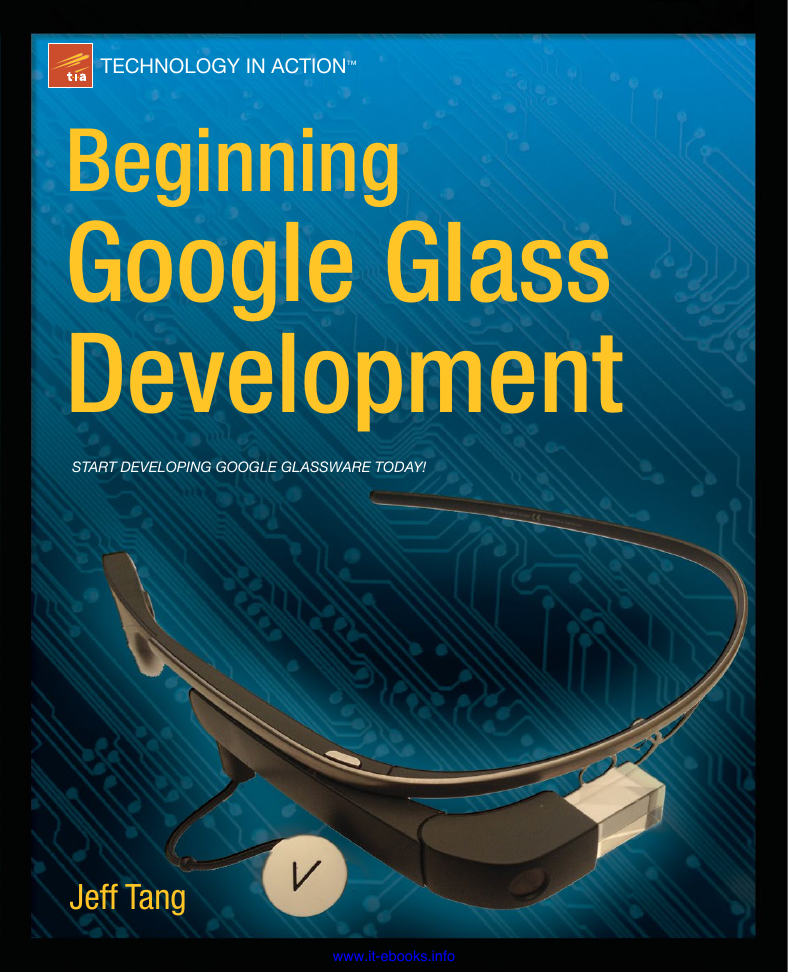
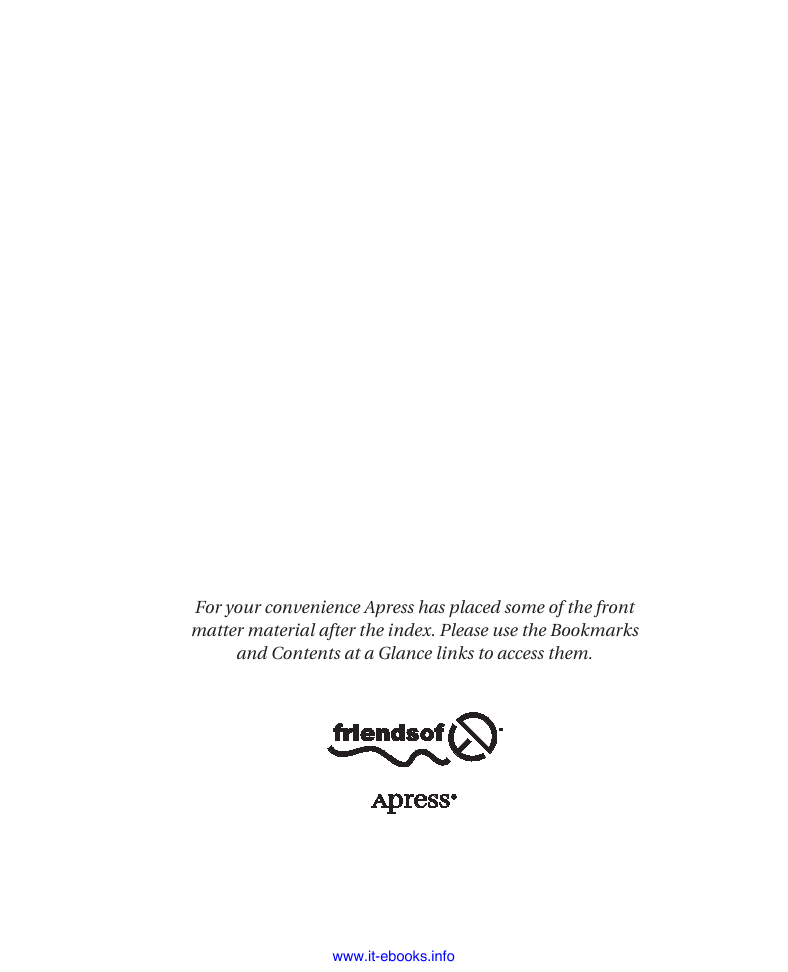
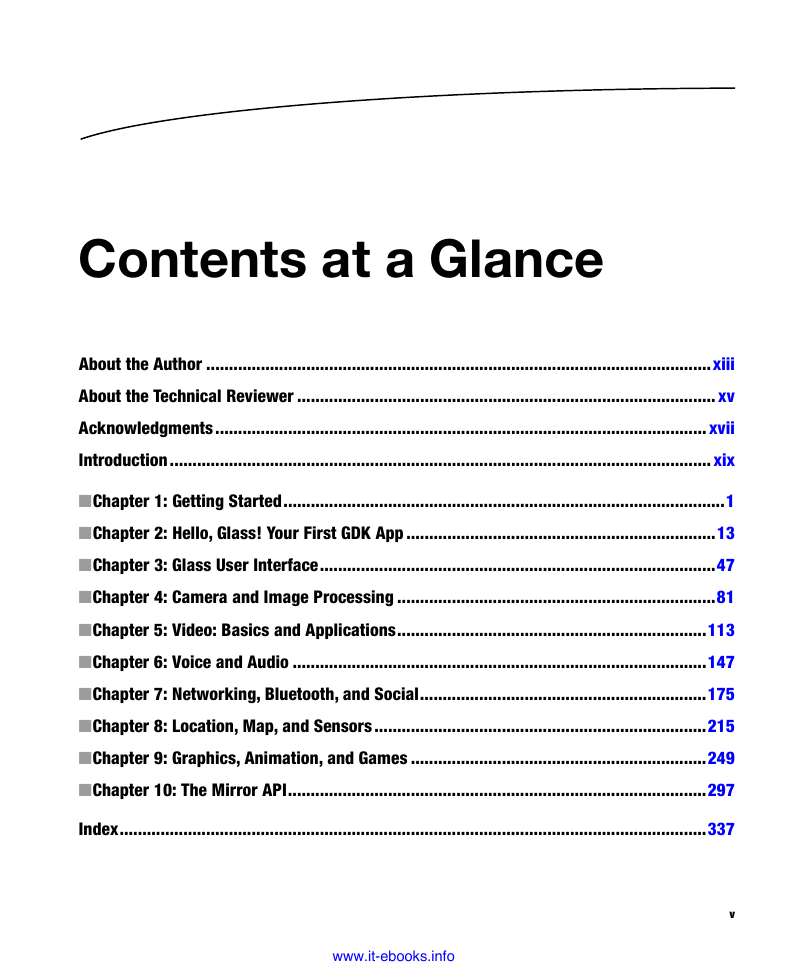
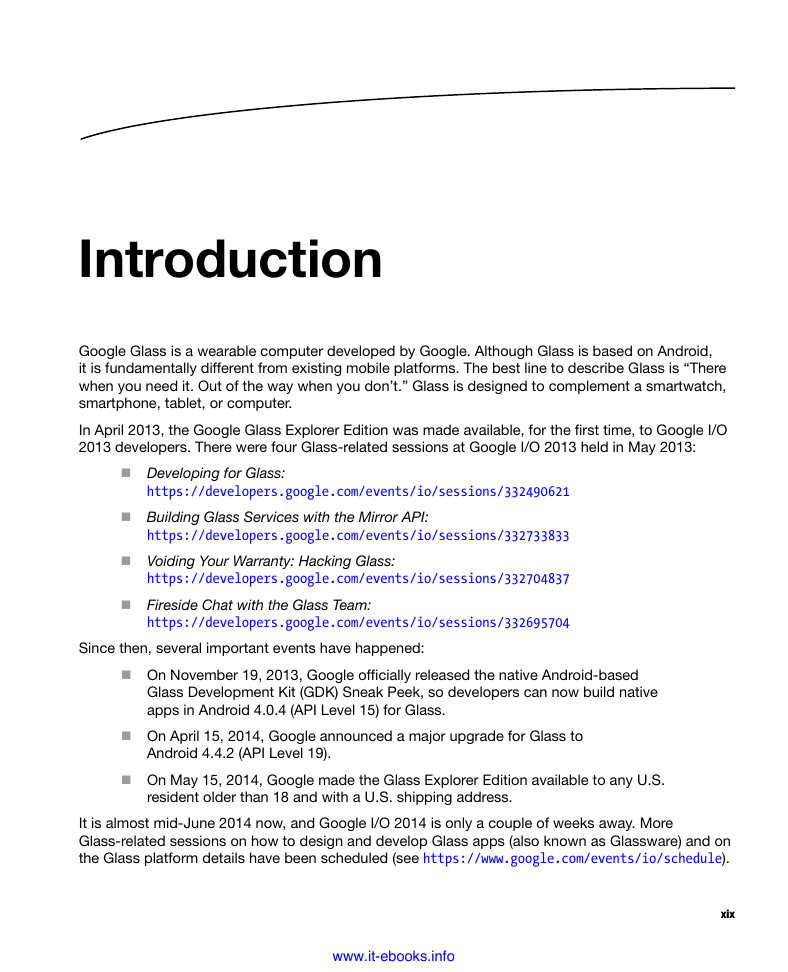
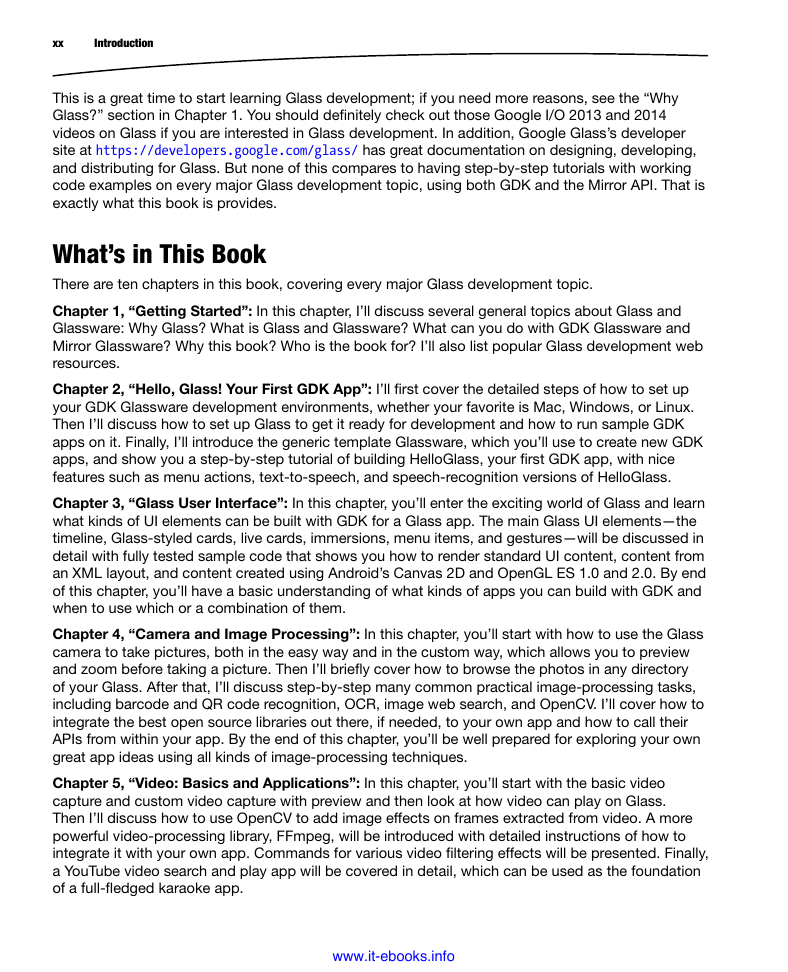
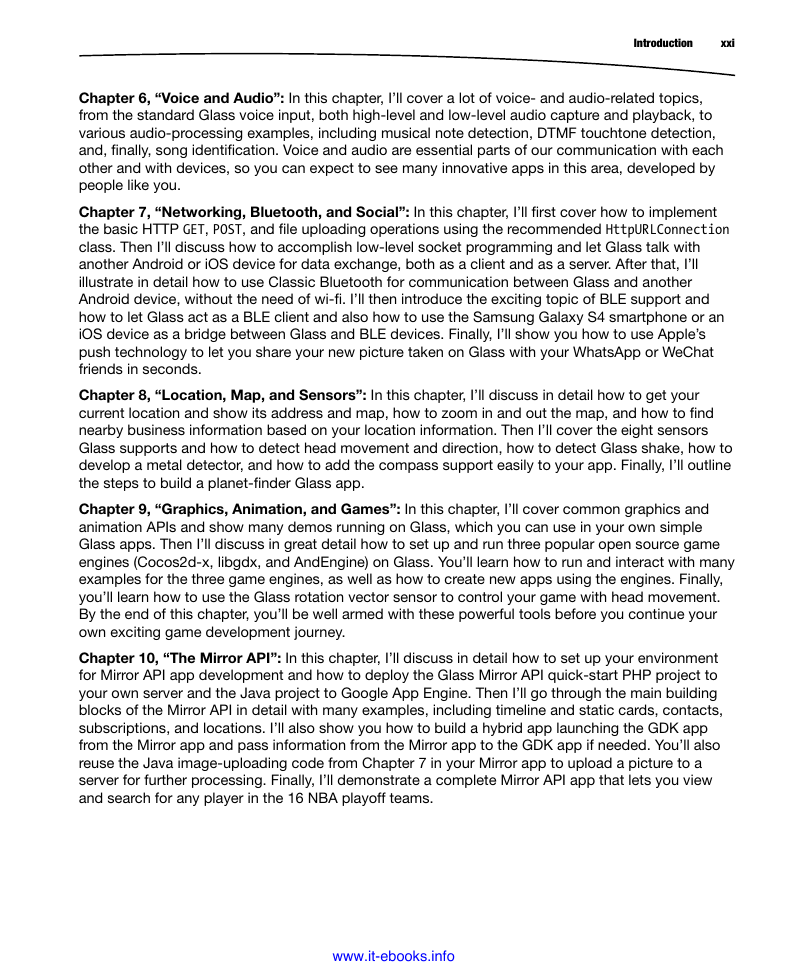










 2023年江西萍乡中考道德与法治真题及答案.doc
2023年江西萍乡中考道德与法治真题及答案.doc 2012年重庆南川中考生物真题及答案.doc
2012年重庆南川中考生物真题及答案.doc 2013年江西师范大学地理学综合及文艺理论基础考研真题.doc
2013年江西师范大学地理学综合及文艺理论基础考研真题.doc 2020年四川甘孜小升初语文真题及答案I卷.doc
2020年四川甘孜小升初语文真题及答案I卷.doc 2020年注册岩土工程师专业基础考试真题及答案.doc
2020年注册岩土工程师专业基础考试真题及答案.doc 2023-2024学年福建省厦门市九年级上学期数学月考试题及答案.doc
2023-2024学年福建省厦门市九年级上学期数学月考试题及答案.doc 2021-2022学年辽宁省沈阳市大东区九年级上学期语文期末试题及答案.doc
2021-2022学年辽宁省沈阳市大东区九年级上学期语文期末试题及答案.doc 2022-2023学年北京东城区初三第一学期物理期末试卷及答案.doc
2022-2023学年北京东城区初三第一学期物理期末试卷及答案.doc 2018上半年江西教师资格初中地理学科知识与教学能力真题及答案.doc
2018上半年江西教师资格初中地理学科知识与教学能力真题及答案.doc 2012年河北国家公务员申论考试真题及答案-省级.doc
2012年河北国家公务员申论考试真题及答案-省级.doc 2020-2021学年江苏省扬州市江都区邵樊片九年级上学期数学第一次质量检测试题及答案.doc
2020-2021学年江苏省扬州市江都区邵樊片九年级上学期数学第一次质量检测试题及答案.doc 2022下半年黑龙江教师资格证中学综合素质真题及答案.doc
2022下半年黑龙江教师资格证中学综合素质真题及答案.doc